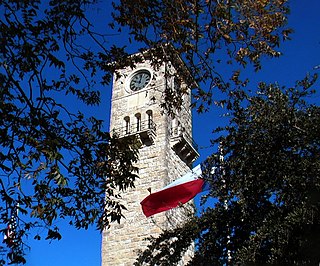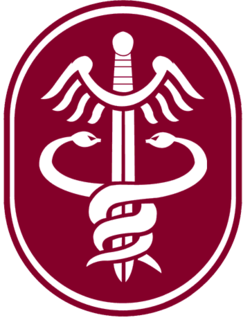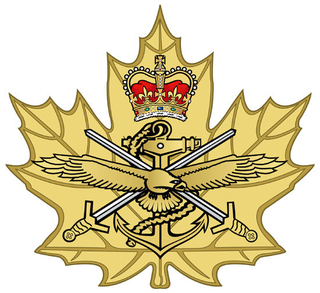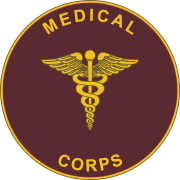Related Research Articles

Military recruit training, commonly known as basic training or boot camp, refers to the initial instruction of new military personnel. It is a physically and psychologically intensive process, which resocializes its subjects for the unique demands of military employment.

Fort Sam Houston is a U.S. Army post in San Antonio, Texas. Known colloquially as "Fort Sam," it is named for the U.S. Senator from Texas, U.S. Representative from Tennessee, Tennessee and Texas governor, and first president of the Republic of Texas, Sam Houston.

The U.S. Army Medical Command (MEDCOM) is a direct reporting unit of the U.S. Army that formerly provided command and control of the Army's fixed-facility medical, dental, and veterinary treatment facilities, providing preventive care, medical research and development and training institutions. On 1 October 2019, operational and administrative control of all military medical facilities transitioned to the Defense Health Agency.

Randolph Air Force Base was a United States Air Force base located at Universal City, Texas.

The Cadet Instructors Cadre consists of approximately 7,500 Canadian Forces (CF) officers whose primary duty is the safety, supervision, administration and training of Royal Canadian Sea, Army, and Air Cadets. The branch is the largest single group within the Canadian Forces reserve force subcomponent Cadet Organizations Administration and Training Service (COATS) and is the largest officer branch in the Canadian Forces. It is also the only branch of the Canadian Armed Forces that doesn't require its officer to hold or be in the process of obtaining a post secondary degree. The COATS subcomponent of the Reserve Force employs members from all branches and occupations of the Royal Canadian Navy, Canadian Army, and Royal Canadian Air Force of the Canadian Forces.

The United States Army's Officer Candidate School (OCS) is an officer candidate school located at Fort Benning, Georgia, that trains, assesses, and evaluates potential commissioned officers of the U.S. Army, U.S. Army Reserve, and Army National Guard. Officer candidates are former enlisted members, warrant officers, inter-service transfers, or civilian college graduates who enlist for the "OCS Option" after they complete Basic Combat Training (BCT). The latter are often referred to as college ops.

The Army Medical Department of the U.S. Army (AMEDD), formerly known as the Army Medical Service (AMS), encompasses the Army's six medical Special Branches. It was established as the "Army Hospital" in July of 1775 to coordinate the medical care required by the Continental Army during the Revolutionary War. The AMEDD is led by the Surgeon General of the U.S. Army, a lieutenant general.

The Medical Corps (MC) of the U.S. Army is a staff corps of the U.S. Army Medical Department (AMEDD) consisting of commissioned medical officers – physicians with either an M.D. or a D.O. degree, at least one year of post-graduate clinical training, and a state medical license.
The Engineer Basic Officer Leader Course (EBOLC), formerly known as the Engineer Officer Basic Course (EOBC), is a training course for new commissioned officers selected for the United States Army Corps of Engineers. It is run at the U.S. Army Engineer School in Fort Leonard Wood, Missouri, United States and lasts nineteen weeks and four days.

Valley Forge General Hospital is a former military hospital in Phoenixville, Pennsylvania. The hospital was near both Philadelphia, Pennsylvania and Valley Forge. It was the only United States Army General Hospital named for a place.

The Air War College (AWC) is the senior Professional Military Education (PME) school of the U.S. Air Force. A part of the United States Air Force's Air University, AWC emphasizes the employment of air, space, and cyberspace in joint operations. Headquartered at Maxwell Air Force Base in Montgomery, Alabama, its higher headquarters is the Air Education and Training Command (AETC) at Randolph Air Force Base in San Antonio, Texas. It is one of six war colleges within the U.S. Department of Defense's Joint Professional Military Education (JPME) Phase II Education Program for commissioned officers.

The Surgeon General of the United States Army is the senior-most officer of the U.S. Army Medical Department (AMEDD). By policy, the Surgeon General (TSG) serves as Commanding General, U.S. Army Medical Command (MEDCOM) as well as head of the AMEDD. The surgeon general's office and staff are known as the Office of the Surgeon General (OTSG) and are located in Falls Church, Virginia.

The U.S. Army Medical Department Museum — or AMEDD Museum — at Fort Sam Houston, San Antonio, Texas, originated as part of the Army's Field Service School at Carlisle Barracks, Pennsylvania. It moved to Fort Sam Houston in 1946. It is currently a component of the U.S. Army Medical Department Center and School.
The Basic Officer Leader Course (BOLC) is a two-phased training course designed to commission officers and prepare them for service in the United States Army. Prospective officers complete Phase I as either a cadet or an officer candidate before continuing on to BOLC B as Second Lieutenants. If BOLC B is not completed within two years of commissioning, 2LTs will be administratively separated from the service unless there are extenuating circumstances. This a progressive model designed to produce US Army officers with leadership skills, small unit tactics and certain branch-specific capabilities.

This article incorporates public domain material from websites or documents of the United States Army.

The Medical Education and Training Campus (METC) is a United States Department of Defense (DoD) integrated campus under a single university-style administration, with nearly 50 programs of study available to U.S. military enlisted students and a small number of foreign military students. METC is located at Joint Base San Antonio on Fort Sam Houston, Texas with a field training site located at Camp Bullis.

The U.S. Army Medical Center of Excellence (MEDCoE) is located at Fort Sam Houston, Joint Base San Antonio, Texas. MEDCoE comprises the 32d Medical Brigade, the U.S. Army Medical Professional Training Brigade (MPTB), and the AMEDD Noncommissioned Officers Academy (NCOA). It serves the U.S. Army in educating and training all of its medical personnel. The Center formulates the Army Medical Department's (AMEDD's) organization, tactics, doctrine, equipment, and academic training support. In 2015, the mission for the Academy of Health Sciences (AHS) moved from the School to the Center, and was renamed the Department of Training and Academic Affairs (DoTAA) as result of a reorganization.

With the purchase of its first airplane, built and successfully flown by Orville and Wilbur Wright, in 1909 the United States Army began the training of flight personnel. This article describes the training provided in those early years, though World War I, and the immediate years after the war until the establishment of the United States Army Air Corps Flight Training Center in San Antonio, Texas during 1926.

The Army Reserve Officers' Training Corps (AROTC) is the United States Army component of the Reserve Officers' Training Corps. It is the largest Reserve Officers' Training Corps (ROTC) program which is a group of college and university-based officer training programs for training commissioned officers for the United States Army and its reserves components: the Army Reserves and the Army National Guard. There are 30,000+ Army ROTC cadets enrolled in 274 ROTC programs at major universities throughout the United States.

Shan K. Bagby is a U.S. Army brigadier general and the 28th Chief of the Army Dental Corps. Bagby also serves as the Commanding General, Regional Health Command-Central. Bagby, an oral and maxillofacial surgeon, was the Army’s first African-American dental officer promoted to brigadier general.
References
 This article incorporates public domain material from websites or documents of the United States Army .
This article incorporates public domain material from websites or documents of the United States Army .
